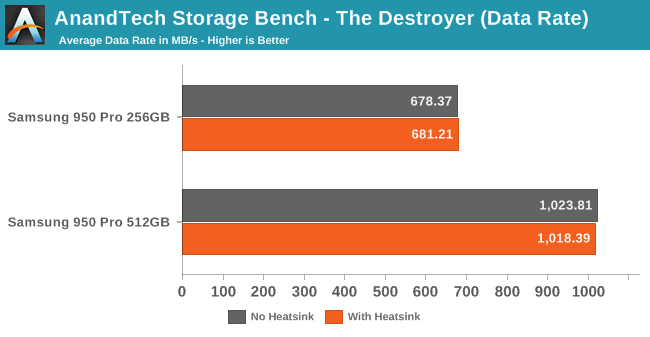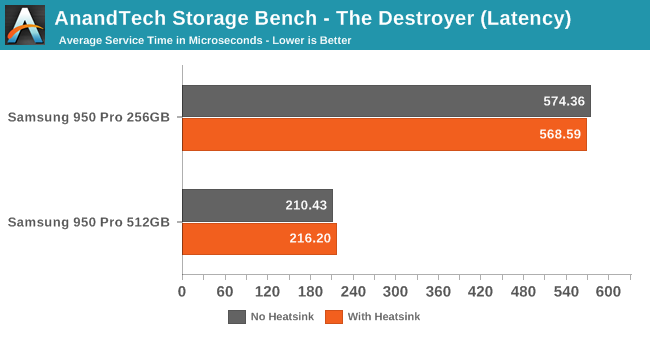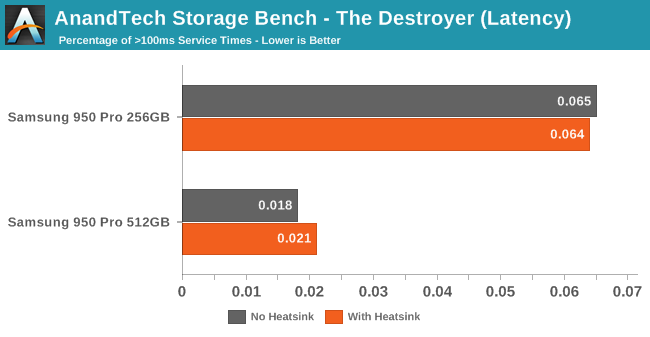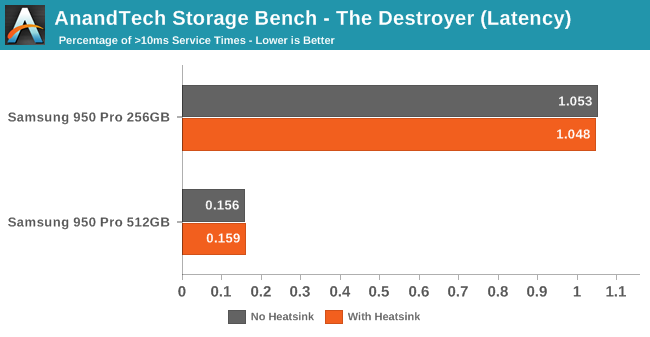The Angelbird Wings PX1 M.2 Adapter Review: Do M.2 SSDs Need Heatsinks?
by Billy Tallis on December 21, 2015 8:00 AM ESTAnandTech Storage Bench - The Destroyer
The Destroyer is an extremely long test replicating the access patterns of heavy desktop usage. A detailed breakdown can be found in this review. Like real-world usage and unlike our Iometer tests, the drives do get the occasional break that allows for some background garbage collection and flushing caches, but those idle times are limited to 25ms so that it doesn't take all week to run the test. Those pauses of up to 25ms are sufficient for the drive to complete a reasonable amount of background processing and return to idle, but they don't give the drive much time to cool off.


Average data rate on The Destroyer was essentially unchanged by the addition of the heatsink. The difference measured for average service time was slightly higher, but still insignificant. In both cases, the heatsink helped the 256GB drive and hurt the 512GB drive.


The frequency of latency outliers was also subject to some variation between runs, but its hard to attribute it to the influence of the heatsink since the effect was in the opposite direction for the two drives. With or without the heatsink the 950 Pro is posting great scores, and the 512GB drive outperforms the 256GB drive by a wide margin.










69 Comments
View All Comments
FunBunny2 - Monday, December 21, 2015 - link
^^that's funny
Breit - Saturday, December 26, 2015 - link
You mean something EKWB did for the Intel 750?http://www.ekwb.com/news/638/19/EK-is-releasing-In...
:D
meacupla - Monday, December 21, 2015 - link
I think this is where all those low profile, frag tape backed, RAM heatsinks, that came along with aftermarket GPU coolers, will come in handy.ironwing - Monday, December 21, 2015 - link
I wonder how much heat 25 LEDs add to a heat sink?mostlyharmless - Monday, December 21, 2015 - link
Yeah, and aren't the fins supposed to be external instead of internal?Billy Tallis - Monday, December 21, 2015 - link
They're really more like ducts than fins as designed. What air does manage to enter the heatsink will not all flow across the entire drive. Some of the fresh cool air will bypass part of the drive, and some of it will just be cooling the heatsink itself. It looks like a design that would be very effective with a lot of airflow, but the intake is pretty small.Billy Tallis - Monday, December 21, 2015 - link
The LEDs draw about 2W. Calculating how much of that gets converted to light that escapes the heatsink is left as an exercise for the reader.MrSpadge - Monday, December 21, 2015 - link
10 - 20 mW each.r3loaded - Monday, December 21, 2015 - link
So what we really need is the 950 Pro in a 2.5 inch drive and the U.2 interface. The bonus is drive capacities of 1TB and maybe even 2TB.Impulses - Monday, December 21, 2015 - link
Great write-up Billy, I appreciate you running the full battery of tests again and re-addressing the Bench scores... A review of a heatsink feels somewhat incomplete without a single temperature measurement tho! SMART readings or something taken with a simple IR thermometer would've been helpful, specially to the kind of DIY'er that's likely to buy this. I'm curious if i can replicate comparable results with a simple stick on heatsink and some airflow, it's particularly relevant for those of us with multiple GPUs where the add in card might put the drive in just as bad of a spot but the M.2 slot might be exposed to more airflow.